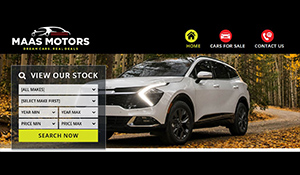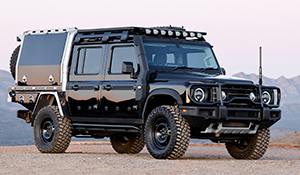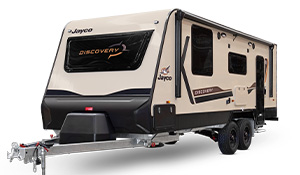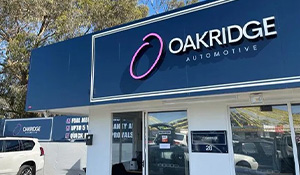80 Series LandCruiser Review 1990 model
To say the new LandCruiser was a giant step forward may be an understatement. In spectacular style it addressed the LandCruiser's deficiencies, and again took the Cruiser to the forefront of 4WD prominence.
Launched in the Snowy Mountains in May 1990, the 80 Series LandCruiser heralded the fact that Toyota was well and truly back in the 4x4 game. It was a thoroughly contemporary 4WD with profound engineering changes. Gone were the old leaf springs, to be replaced by long travel coils all round. Most variants were equipped with constant 4WD, all-disc brakes and centre diff lock - as per the Range Rover, many years previous.
The ten-model (8 recreational models) LandCruiser 80 Series shared all new metal work, smoother, more stylish body with a distinctive bar-type grille, and longer wheelbase. As well as being more efficient aerodynamically than the previous shape, the new body offered greater passenger room and luggage space. It was a mid-roof style in place of the previous low-roof and high-roof options. This was an improvement as the volume-selling variants enjoyed increased headroom. There were six constant 4WD versions and two part time, all with power steering.
All body panels were made from corrosion-resistant steel.
The 80 Series came in three trim levels - Standard, GXL and VX Sahara - priced from $32,794 to $77,634.
Standard models were aimed mainly at fleet buyers, and were fitted with practical vinyl trim, rubber mats and steel wheels. They also had selectable rather than constant four-wheel-drive. They were powered by either a 4-litre carburettor six at $32,794 or a 4.2-litre diesel at $35,314.
The GXL featured full time 4WD and disc brakes and was available in petrol at $37,200, a fuel-injected (EFI) 4.0-litre petrol auto at $41,365 and diesel manual at $41,640. The top of the range VX Sahara boasted CD player and an icebox in the centre console.
GXL and VX wagons had a third row of seats, allowing them to carry eight passengers. The VX was available with the EFI petrol auto at $69,194, the 4.2-litre turbo diesel manual at $74,458, and the turbo diesel auto at $77,634.
These were new or reworked engines, with both petrol and diesel producing increased power. They included a four-litre petrol and a pair of 4.2-litre diesels. The standard petrol engine developed 110kW of power at 4200 rpm and 284Nm of torque at 2200 rpm. The EFI version developed 112kW at 4000 rpm and 290Nm at 3000 rpm.
Toyota's new turbo diesel developed 115kW at 3600 rpm and 357 Nm at 1800 rpm, which made the 80 Series the world's most powerful 4x4 diesel wagon.
The petrol engine was now fuel injected with electronic ignition. These improvements, along with some work to reduce noise and vibration, transformed it into a relatively refined powerplant.
Transmissions were strengthened and re-geared to cope with the new engines' greater power and torque. The drive line had a mechanical centre diff fitted with an electronic-servo diff lock which automatically engaged in low range and a limited slip rear differential. The VX had front and rear diff locks. Solid axles were suspended by coil springs and gas dampers all round, a five-link system at the rear and leading arms and a Panhard rod at the front. Wheel travel was greater, with spring rates softer than the previous all leaf system. Brakes were improved and the LandCruiser had more accurate steering and a tighter turning circle.
All variants except the petrol-engines automatic came with long range fuel tanks holding 145-litres.
The Models
There were ten models in the 80 Series range, eight of which were recreational models. There was a choice of four engines, manual or automatic transmission, and three levels of trim.
The LandCruiser 80 Series wagon was offered in three grades (standard, GXL and VX Sahara) each targeted at a specific market segment by price and specification level.
All ten models had a mid-roof replacing the previous low and high roof designs.
Four engines were available - all six cylinder. These were the new 4.2-litre turbocharger 1HD-T, its naturally aspirated version the 1HZ, the newly EFI-equipped 4.0 litre 3F-E petrol, and the proven 4.0 litre 3F petrol.
The new turbocharged 1HD-T diesel engine could be matched to a five-speed overdrive manual or four speed overdrive automatic transmission, with lock-up clutch on the torque converter. Automatic versions had the EFI-equipped 3F-E engine.
The standard wagon was available with petrol or a naturally aspirated diesel engine and manual transmission. It had swing-type rear doors with washer/wipers and demisters on both doors.
The constant 4WD GXL was aimed at the private recreational buyer. It was offered as a petrol manual, EFI petrol, diesel manual, and turbo diesel manual and automatic.
GXL had constant 4WD, four-wheel disc brakes, wide wheels and tyres, three rows of seats (the third row easily removed), carpet, a rear cabin heater unit, power windows, power mirrors and power door locks, and an AM/FM stereo radio cassette unit.
Constant 4WD VX Sahara was aimed at luxury vehicle buyers. It was available as an EFI petrol auto, turbo diesel manual and turbo diesel automatic. The VX Sahara shares the GXL's features and has another 14 exclusive features.
Passenger comforts
The new 80 Series offered car-like interiors with increased cabin space, comfort levels and reduced interior noise. Steering response, gear change efforts, controls, ventilation, air conditioning, instrumentation, seats and audio equipment were all improved.
The interior featured a smooth integrated finish, a rounded cockpit-type instrument panel, characterised by short-reach levers and switches, and excellent panel visibility. The controls include tilt-adjust steering, power steering and collapsible steering column. All models have child-proof locks on rear doors. The GXL had a five speaker audio system, the VX Sahara a nine speaker system.












